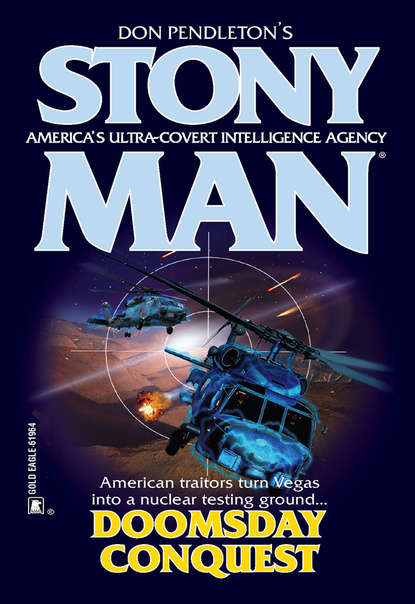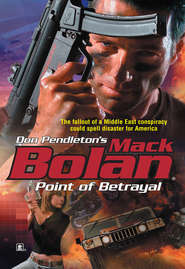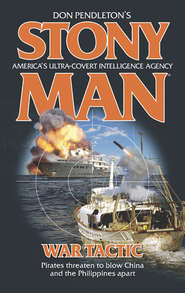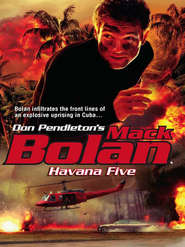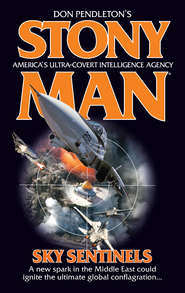По всем вопросам обращайтесь на: info@litportal.ru
(©) 2003-2024.
✖
Doomsday Conquest
Автор
Год написания книги
2019
Настройки чтения
Размер шрифта
Высота строк
Поля
When the payloads were launched, gun cameras in the guidance systems of each nose, he knew, would track their flight paths, speeding bullets, near skimming U.S. government-owned prairie of North Dakota, until impact flashed obliteration then oblivion across the screens. Four payloads all told, he thought, what were technically cruise missiles, streaking at low altitude for the mock-ups, powered at subsonic speed to target by jet engines. Digital contour maps, born from radar and aerial and sat imagery, told the computer navigational systems in the warheads where to go.
Predestined supertech boogie-woogie.
Only these mothers of annihilation, code-named the Four Points, Horn knew, housed a series of thermal cluster bombs, eight to a package, two more inside each eight. As he did the math, recalling the computer graphics outlining the blast radius, he pictured smoking craters—or dozens of raging infernos—eating up something in the combined neighborhood of four to five square miles.
Sweet.
Welcome to the war of the future, he thought, aware that if this test run was successful, the empty wastelands of Nevada were next up, and in for a whole other galaxy of big bangs.
As Horn glimpsed Colonel Jeffreys moving his way, he pulled the pack of Camel unfiltered cigarettes from his pants pocket, stuck one on his lip. Clacking open his Zippo lighter and torching up, spitting tobacco flecks then dragging deep, he saw the head aerospace genius, Dr. Benjamin Keitel, glaring his way.
“Hey! Are you nuts? There’s no smoking in here!”
Horn washed a dragon’s spray of smoke toward Keitel, the man flapping his arms like a headless chicken, a couple more of his comrades jumping into the act. The geek was squawking out the virtues of nonsmoking to Jeffreys when Horn blew another cloud in his face and told the colonel, “Maybe you want to remind Dr. Frankenstein here who’s really in charge?” He ignored Keitel’s diatribe, adding, “Maybe you want to inform him I don’t exactly hand out pink slips at the end of the day for insubordination?”
“Get back to work,” Jeffreys told the aerospace engineer, who muttered something to himself then returned to his monitors.
Horn stared ahead, puffing, as the good colonel scowled him up and down. He could almost hear the man’s thoughts. Beyond the shoulder-holstered Beretta 92-F, if not for the white star emblem over his heart on his blacksuit, Jeffreys could pull rank.
“If I were you, I wouldn’t be so free in issuing implied threats like that, Mr. Orion,” the colonel said, layering disdain on his code name like a curse word.
“Well, you’re not me.”
“And I pray every night that blessing will continue.”
“Really?” Horn smoked, bobbed his head, got the message, hoping the day came when Jeffreys crossed into what he liked to call the Black Hole. “Fear not, Colonel. I’m not about to turn my quarters into a torture chamber,” he said, then, looking at the two female engineers, smiled and added, “or a rape room.”
“You son of a… Don’t you have some business to attend to, regarding an AWOL and, may I add, critical employee of this program?”
“We’re working on it. Something this sensitive, Colonel, it takes time,” Horn said as Jeffreys moved into his personal space.
“Time better served if you were, I would imagine, out there as point man in the hunt.”
Horn was searching for some threatening reply when he caught the change in tone from Keitel, questions hurled from his work bay, edged with concern as they were snapped into his com link. The SAS commander took a few steps forward, sensing a problem as he peered into the monitors where the executive jets mirrored Lightning Bat. The air became lanced, he felt, with rising panic as he saw what he believed were blue flames—or sparks?—leaping from the black ferrite-painted surface of the fighter jet, dancing next, nose to tail, there then gone. What the hell had just happened? he wondered, Kietel barking the same question to Major Holloran. Lightning Bat’s coating, he knew, was meant to absorb radar radiation, standard for any Stealth fighter to render it near invisible. Only he was privy there was more to the fighter jet’s body, from nose to swept-back Delta wings to tail, than earthly alloys.
Jeffreys banging out questions, Horn rolled up Keitel’s back. And clearly saw what looked like blue lightning shooting from the cockpit.
“Lightning Bat Alpha!” Keitel nearly shouted. “You are nowhere near the targets.”
“Why are the bomb bays opening?” Jeffreys demanded, checking his watch. “They’re way ahead of their scheduled launch!”
Horn heard Keitel gasp an oath as he saw the missiles lowered from their bay by the robotic arms. “Lightning Bat Alpha, respond!” he hollered, eyes darting from a digital readout to the play-by-play screens, snarling next as he pulled the com link from his ears, static crackling through the room like a string of firecrackers. “Colonel,” Keitel said, eyes bugged to white orbs, “all Four Points are recalibrating their targets!”
“What? How?” he demanded, flying up on Keitel’s rear. “Where?”
Horn was crowding Keitel and Jeffreys when he heard Holloran patch through, the panic in the major’s voice loud and clear through the static. “Ground Control, come in, dammit! We have a colossal and definite problem!”
Keitel looked about to vomit, sounding on the verge of hyperventilating as he tapped the keyboard on his computer. As a digital grid map of North Dakota flashed onto the monitor, Keitel paused, staring in horror at the blinking red dots. “Oh, God, no. This can’t be happening!”
“What?”
Keitel turned to Jeffreys, his face ashen, and told him, “All four missiles are recalibrated to strike civilian targets.”
“SWITCH TO MANUAL override!”
Targets Engaged flashing in red on the head up display from the holographic image illuminated by laser light on the inside of his visor, Holloran stifled the urge to smash his fist into the instrument panel.
“I can’t,” Sayers told him, his fingers flying over the keypad that would shut the targeting computer system down. “Dammit to hell, it’s locked up!”
Holloran swore under his breath. This was the next-to-ultimate nightmare scenario—four cruise missiles with cluster bombs set to launch and take out civilian targets—as he heard ground control telling him what he already knew.
The two of them were on their own.
Do something!
For all the four-digit Einstein IQ between them—there was nothing Eagle Nebula could do on its end. Short of blowing them out of the sky with a SAM—and he wouldn’t put it past them—there was one other option, he knew, waiting now for those three dreaded words.
Initiate Fatal Abort.
From the beginning, no ejector seats, no self-destruct button had been designed for Lightning Bat. There was good reason for that, he knew, fully accepting from the onset the twisted reasoning that IFA meant finding a vast and wide-open stretch of nothing and slamming Lightning Bat to Earth. A suicide ditching, a fireball spewing radiation, but hopefully nowhere close to a populated area. Or, at worst, only a few souls hopefully still wandering around outside Ground Zero, until Eagle Nebula could ferry in the hazmat platoons while soldiers quarantined God only knew how many square miles around the compass.
Holloran switched his HUD to the inside of the cockpit shield, wondering why some systems worked and others were—well, acting on their own, rebelling, as if they had willpower, defiantly commandeering the vessel. He grabbed the side-arm controller, hoping to God if he could throw the wings to a quick dip, forty-five degrees, port and starboard, the missiles might impact on what was empty prairie. Provided, of course, he got the timing right, but with everything else unraveling…
The stick was jammed!
And the blue lightning came back, leaping from the instrument panel, as Holloran found their own retractable cameras lower from each side of the hull’s underbelly amidships, zooming in on the two robotic arms lowering their payloads.
Targets Engaged freeze-framed on the shield.
Holloran cursed, rechecking the new calibrations, locked in still, he discovered, ground control screaming in his ear as the payloads fanned out into crossbars on their monitors.
Covering north, south, east and west, two on an arm, one frame hung a few meters lower than the other, and for the sake of what was now doomsday clearance. Just as they pulled the damn things up on their computers, he knew, they were held for the moment by titanium clamps, talons that would release them at any second as he watched the numbers fall to single digits on his readout.
Holloran stared at the vast prairie, looked to a long, sweeping horizon that seemed to run straight into the setting sun. They were still some fifty miles from the Badlands, Holloran certain, or rather praying, they were as empty as the lunar landscape he knew them to be.
“They’re going to fire, Major!”
And Holloran watched in helpless rage and disbelief as four cones of flame shot out beyond the stabilizing fins. The missiles released and went streaking away on four points of the compass.
GROUND CONTROL, Horn knew, was an obscene misnomer, and by galactic degrees in this case. There were no command guidance systems, at least for this initial outing, to depend on laser beams to pin down the targets to within a few meters, steer and keep the missiles locked in to impact. No passive system, either, meaning they homed in specifically on infrared radiation, as in heat-seeking the likes of auto or jet engines—or warm bodies. The Four Points were their own Alpha and Omega, relying solely on active systems, which was radar already engineered into the missiles, their guidance computers flying them on, unstoppable and untouchable, to vaporize the targets. Keitel was in the process of pointing this out to Colonel Jeffreys, they were little more than limp baggage on this end.
“Sweet Holy Virgin Mother of…”
“I’m afraid we are way past any hand of God, Colonel.”
“Don’t get smart on me, Keitel! Where are those missiles fixed to strike, mister?” the colonel rasped, clear to all now he realized he had become a master of the obvious by rattling off questions he already had the answers to from double-digit briefs.
The good Major Holloran seemingly all but forgotten for the moment, Horn watched as Keitel slammed in a series of numbers on one of his readouts, then hit his computer keyboard, informing the colonel he would bring up the targets on the wall. Looking past the workstation, Horn stared at the project’s emblem, thirty feet by twenty, painted on the stark white wall, dead ahead. The Eagle Nebula, he recalled, was a bright cluster of young evolving stars, but a massive gas formation, still condensing though not nearly thermonuclear enough to shine like Earth’s sun. Imaged by the Hubble Space Telescope only as recently as 1995, the dark nebulosity was more widely known among the deep space stargazers as “the Pillars of Creation.”





